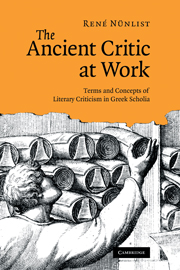Book contents
- Frontmatter
- Contents
- Acknowledgments
- Introduction
- PART I
- PART II
- 13 The gods in Homer
- 14 Homeric similes
- 15 Epithets
- 16 Type scenes
- 17 Homeric speeches
- 18 Reverse order
- 19 Staging, performance and dramaturgy
- Epilogue
- Glossary of Greek terms
- Editions of scholia
- Other abbreviations
- Bibliography
- Thematic index
- Index locorum
18 - Reverse order
Published online by Cambridge University Press: 29 August 2009
- Frontmatter
- Contents
- Acknowledgments
- Introduction
- PART I
- PART II
- 13 The gods in Homer
- 14 Homeric similes
- 15 Epithets
- 16 Type scenes
- 17 Homeric speeches
- 18 Reverse order
- 19 Staging, performance and dramaturgy
- Epilogue
- Glossary of Greek terms
- Editions of scholia
- Other abbreviations
- Bibliography
- Thematic index
- Index locorum
Summary
The structural principle here called ‘reverse order’ is regularly referred to in ancient and modern scholarship on Homer, but there is no generally accepted term to designate it. ‘Reverse order’ describes the Homeric narrator's tendency to return first to the last of a series of two or more elements previously mentioned. Therefore, the structure of the principle can be represented as: A–B—B’–A’. To give an example:
τίς ταρ τῶν ὄχ᾽ ἄριστος ἔην, σύ μοι ἔννεπε, Μοῦσα,
αὐτῶν (Α) ἠδ᾽ ἵππων (Β), οἳ ἅμ᾽ Ἀτρεΐδῃσιν ἕποντο.
ἵπποι (Β᾽) μὲν μέγ᾽ ἄρισται ἔσαν…[4 lines omitted]
ἀνδρῶν (Α᾽) αὖ μέγ᾽ ἄριστος ἔην …
(Il. 2.761–3, 768)The horses, which are mentioned last, are taken up first, which is especially striking as one might expect precedence to be given to the human fighters. This Homeric structural principle was well known to Aristarchus, who referred to it with the phrase πρὸς τὸ δεύτερον πρότερον ἀπαντᾶν, for example in the scholion on the quoted passage.
ὅτι πρὸς τὸ δεύτερον πρότερον ἀπήντηκεν.
(schol. A Il. 2.763 Ariston.)<The diple,> because he [sc. Homer] has taken up the second [i.e. the horses] first.
The extant corpus of scholia provides a remarkably high number of notes which comment on the principle. Perhaps even more interesting is the fact that the scholia contain traces of a scholarly debate as to whether the principle is always adhered to or not.
- Type
- Chapter
- Information
- The Ancient Critic at WorkTerms and Concepts of Literary Criticism in Greek Scholia, pp. 326 - 337Publisher: Cambridge University PressPrint publication year: 2009



